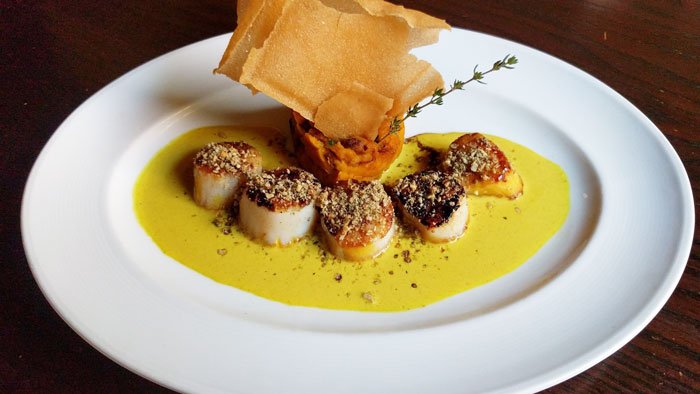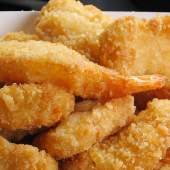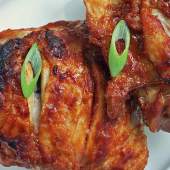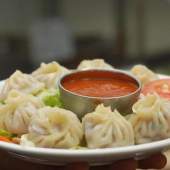A Q&A with the Team at de Quay

Hey Chicago! What an exciting week it has been for us. Go Cubbies! In this week’s episode, we visit de Quay in Lincoln Park – on the only Dutch-Indonesian restaurant in Chicago. I spoke to David de Quay, executive chef and owner of de Quay, to learn more about what he’s cooking up at his spot and some tips for navigating the menu. And General Manager and Wine director Terry McNeese and Beverage Director Noel Catrambone chime in with some must-try beverage recommendations. Here’s what they had to say:
Q. DeQuay focuses on Dutch-Indonesian cuisine. However this isn’t where you come for rice table or some of the other traditional aspects of this cuisine. So what can diners expect? What are some of the flavors and ingredients that define this style of cuisine?
David de Quay: Although most people think more towards Indonesian and the Rice Table dining experience when they hear “Dutch-Indonesian,” de Quay is more of a cross-cultural fusion of the recipes, ingredients, and flavors from both countries. That being said, diners can expect bits and pieces from both worlds fused together in some dishes. Other dishes are definitely very Indonesian or very Dutch influenced. The Nasi Goreng Istemewa, Gado-Gado Salad, and Chicken Sate are traditional Indonesian dishes but done in a more modern way, and the Dutch Fall Chicken Stew and Stroopwafel dessert are uniquely Dutch. Most of the other dishes I would describe as a cross- cultural mix of flavors and ingredients from both worlds.
Indonesian flavors are a bit spicy, use a good amount of hot finger peppers, sambals (traditional chili spiced condiment that we make in house with different flavors), curries from different Islands of Indonesia, sweet soy sauce, turmeric, garlic, ginger, lemon grass, and coconut. The Dutch profile would be in the realm of clove, nutmeg, Anise, Cinnamon, smoked pork (i.e., the rookworst a typical Dutch smoked Pork in Chicken dish), and of course dairy and cheeses – especially in the Gouda family where we use a pepper Gouda for the dumplings and goat Gouda in the lamb entree. Dutch chocolate is also a part of the dessert menu in the Coconut Rocher dessert mixing curry and coconut flavors of Indonesian with Dutch Chocolate Cream. Almond paste in the Spekkoek dessert is used frequently in typical Dutch desserts as well.
One of the things I tell people about our menus is that you can sort of customize your own Rice Table menu in a unique way, with items like the Chicken Sate, Dumplings, Gado Salad, Nasi Goreng, and Balinese Mussel Dish. And then whatever you are in the mood for, try a few of the entrees which cover many different bases. Our desserts are very uniquely Dutch/Indonesian creations. Spekkoek, a Dutch layered Almond Cake combined with Pandan (a very Indonesian flavor/ingredient) Ice Cream is an example of that.
 Pan-seared Jump Scallops at de Quay
Pan-seared Jump Scallops at de Quay
Q. For someone new to this style of food, how would you suggest they order to ensure they walk away with a solid sense of the style of cuisine at de Quay?
David de Quay: To get the full “de Quay” experience, I would suggest guests try several things from all three of the sections of the menu. The “cross-cultural” dishes like the Duck Leg Confit, Brabander Autumn Salad, Dumplings, and the Lamb Duo entree are good examples, as well as the Rocher and Spekkoek dessert. If a guest is more interested in the Indonesian flavors, the Nasi Goreng and Chicken Sate are modern representations of Indonesian specialties.
Q: I know it’s like choosing your favorite child, but what’s the can’t-miss dish that everyone should try?
David de Quay: That’s a tough one! It’s a tie between Dumplings, Duck Leg Confit, Nasi Goreng, and Lamb Duo. If I had only one to choose I would probably go with Duck Leg Confit, which is a meld of delicious flavors from both worlds and a unique representation of our concept.
Q: It’s clear a lot of thought and care goes into the wine program at de Quay. Tell us a bit about how the program is designed, highlight some unique or stand-out offerings, and help us with some tips for pairings for Dutch-Indo cuisine.
Terry McNeese: With the wine program, our goal is to offer a compact but well-curated wine list featuring wines from Europe and the United States. We strike a balance between the familiar and an opportunity for the curious to try something new. Our guests are welcome to have a sip of any of our glass pours so that they can find one they really like. Rieslings are my passion and they pair quite well with David’s cuisine. Start with a glass of the incomparable Balthazar Ress 1997 Spatlese Riesling from a vineyard site in the Rheinghau which dates back to Roman times.
Q. You also have a solid cocktail program. If one prefers to drink cocktails, what are some suggestions for pairing cocktails with the meal?
Noel Catrambone: At de Quay our cocktails are all about balance. This is what we’re striving for with each drink. We want our cocktails to be a cohesive part of the experience, and we believe that by creating recipes that are flavorful and well balanced, we are able to offer some intriguing options for guests to enjoy with their meal. Keeping it seasonal is key, and right now we’re all thinking about fall flavors. For example, David is serving a beautiful tamarind-glazed confit duck leg with homemade Dutch gingerbread. We like to pair that with the Burnt Sienna – a smooth, smoky mezcal old-fashioned with brown sugar and clove, that echoes the richness and spice of that dish.
Stay tuned next week for three more great restaurants and some more inside dish right here on my blog!
Cheers,
Catherine





